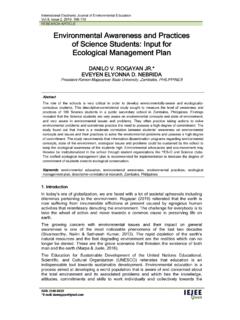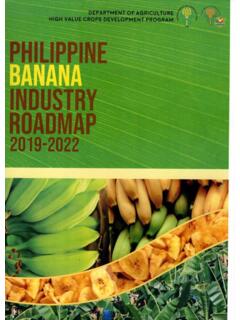Transcription of Philippines: Energy Sector Assessment, Strategy, and Road …
1 Philippines Energy Sector assessment , strategy , and road Map This Energy Sector assessment , strategy , and road map documents the status and strategic priorities of the Government of the Philippines in the Energy Sector . It highlights Sector performance, development constraints, government plans and strategies, past support of the Asian development Bank (ADB) and other development partners, and the strategy for future ADB support in the Energy Sector . It also provides Sector background information for investment and technical assistance operations. The assessment is based on a systematic review of the Philippines' Energy Sector and consultations with the government and other development partners.
2 About the Asian development Bank ADB is committed to achieving a prosperous, inclusive, resilient, and sustainable Asia and the Pacific, while sustaining its efforts to eradicate extreme poverty. Established in 1966, it is owned by 67 members . 48 from the region. Its main instruments for helping its developing member countries are policy dialogue, loans, equity investments, guarantees, grants, and technical assistance. PHILIPPINES. PHILIPPINES. Energy Sector assessment , strategy , and road MAP. OCTOBER 2018. Asian development Bank 6 ADB Avenue, Mandaluyong City 1550 Metro Manila, Philippines ASIAN development BANK.
3 PHILIPPINES. Energy Sector assessment , strategy , and road MAP. OCTOBER 2018. ASIAN development BANK. Creative Commons Attribution IGO license (CC BY IGO). 2018 Asian development Bank 6 ADB Avenue, Mandaluyong City, 1550 Metro Manila, Philippines Tel +63 2 632 4444; Fax +63 2 636 2444. Some rights reserved. Published in 2018. ISBN 978-92-9261-362-4 (print), 978-92-9261-363-1 (electronic). Publication Stock No. TCS189616. DOI: The views expressed in this publication are those of the authors and do not necessarily reflect the views and policies of the Asian development Bank (ADB) or its Board of Governors or the governments they represent.
4 ADB does not guarantee the accuracy of the data included in this publication and accepts no responsibility for any consequence of their use. The mention of specific companies or products of manufacturers does not imply that they are endorsed or recommended by ADB in preference to others of a similar nature that are not mentioned. By making any designation of or reference to a particular territory or geographic area, or by using the term country . in this document, ADB does not intend to make any judgments as to the legal or other status of any territory or area. This work is available under the Creative Commons Attribution IGO license (CC BY IGO).
5 By using the content of this publication, you agree to be bound by the terms of this license. For attribution, translations, adaptations, and permissions, please read the provisions and terms of use at #openaccess. This CC license does not apply to non-ADB copyright materials in this publication. If the material is attributed to another source, please contact the copyright owner or publisher of that source for permission to reproduce it. ADB cannot be held liable for any claims that arise as a result of your use of the material. Please contact if you have questions or comments with respect to content, or if you wish to obtain copyright permission for your intended use that does not fall within these terms, or for permission to use the ADB logo.
6 Notes: In this publication, $ refers to United States dollars. ADB recognizes China as the People's Republic of China and Korea as the Republic of Korea. Corrigenda to ADB publications may be found at On the cover: Solar panels from a hybrid Energy system on Cobrador Island, Philippines (photo by ADB). Contents Tables and Figures iv Acknowledgments v Abbreviations vi Currency Equivalents vii Weights and Measures vii I. Introduction 1. II. Overall Sector Context 2. A. Energy Resources 3. B. Energy Balance 4. C. Forecasts for Energy Supply and Demand 5. D. Climate Change 7. III. Institutional Context 8.
7 A. Government Institutions in the Power Sector 8. B. State-Owned Enterprises 10. C. Private Sector 11. IV. Core Sector Issues 13. A. Electric Power Subsector 13. B. Energy Efficiency 20. C. Energy Resource Subsectors 21. D. Subsector Constraints 30. V. Sector strategy 37. A. Power Sector Priorities 37. B. ADB's Sector Support Program and Experience 39. C. Other development Partner Support 40. D. ADB Experience and Self-Evaluation 42. E. ADB's Sector Forward strategy and Policy Issues Moving Forward 42. VI. Energy Sector road Map and Results Framework 47. Appendix: Energy Sector Problem Tree 48.
8 Iii Tables and Figures Tables 1 Energy Supply Projections for 2040 6. 2 Current Transmission Interconnection Capacity in the Philippines 19. 3 Approved Feed-In Tariff Rates as of 31 December 2016 28. 4 National Energy Targets Set Out by the philippine development plan 2017 2022 38. 5 Energy -Focused Legislative Agenda from the philippine development plan 2017 2022 39. 6 Major Donor Activities in the philippine Power Sector , 2010 Onward 41. Figures 1 Regional Real Gross Domestic Product Growth, 2003 2016 2. 2 Electricity Demand Growth vs. Real Gross Domestic Product Growth 5. 3 Structure of the Power Industry in the Philippines 8.
9 4 Power Generation by Source in the Philippines, 1991 2016 13. 5 Supply and Reserve Margins in Luzon, 1987 2016 14. 6 Generation in the Main philippine Grids, 2016 15. 7 System Losses in the Philippines 18. 8 Installed Renewable Energy Capacity under the Feed-In Tariff Program 29. 9 Retail Tariffs for Residential Customers as of September 2017 30. 10 Comparison of Generation Charge by Meralco vs. Wholesale Electricity 31. Spot Market Prices . 11 Strategic Linkages 43. iv Acknowledgments This report was prepared by a team led by Shannon Cowlin, senior Energy specialist, Energy Division (SEEN) of the Southeast Asia Department (SERD), with team members: Rehan Kausar, director, Portfolio Management Division of the Procurement, Portfolio, and Financial Management Department; Manfred Kiefer, senior economist, Private Sector Transaction Support Division of the Private Sector Operations Department; Michael Thomas, consultant, and Christopher Starling, consultant.
10 Guidance and support was provided by Ramesh Subramaniam, director general, SERD;. Andrew Jeffries, director, SEEN; and Kelly Bird, director, Philippines Country Office (PHCO). The team wishes to thank Yongping Zhai, chief, Energy Sector Group, Sustainable development and Climate Change Department; Aekapol Chongvilaivan, country economist, PHCO; and Anthony Jude, consultant, for their helpful reviews and comments during the preparation of the report. The team wishes to thank the Department of Communications and SERD staff: April-Marie Gallega, associate communications coordinator; Mary Grace Huelgas, associate operations officer; and Jeffrey Almera, senior operations assistant, for their support in preparing and editing the report.











